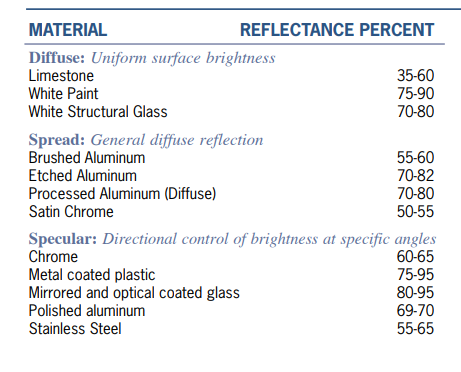Commercial lighting design can improve the productivity and efficiency of employees by providing the right amount of light for them to be able to do their jobs safely. For example, a warehouse where employees are often using heavy machinery will need brighter, more expansive lighting than a restaurant or individual office will. Keep reading for 15 tips to consider for your next lighting design project.
1. Be Aware of How Much Light You Need
Lighting in a space is usually measured in “foot-candles,” or the number of Lumens per square foot. Here are some general guidelines for how many foot-candles different types of spaces should have:
- Retail: 50 foot-candles
- Department Store: 40 foot-candles
- Auto shop: 50 foot-candles
- Classrooms: 40 foot-candles
- Factories: 30-100 foot-candles
- Hallways: 20-25 foot-candles
- Warehouse: 10-30 foot-candles
A useful equation for knowing how many lighting fixtures you need for a space is: “multiply the space’s total square footage by the suggested number of foot-candles and then divide that number by the lumen output of the fixture you wish to use” (Steel Lighting Co.).
2. Use a Consistent Light Temperature
Lighting fixtures and bulbs come in a range of colors and temperatures. Using a consistent temperature is key to creating the ambient environment of a space as well as unifying the design.
As ConTech Lighting says, “Correlated Color Temperature, or CCT, is a measure of a lamp’s color appearance when lighted. All lamps are given a color temperature based on the color of the light emitted. White light falls into three general categories: warm, neutral and cool, measured in Kelvin (K).
White light with a hint of yellow-like candlelight is called “warm white” (below 3000K); it enhances reds and oranges, dulls blues, and adds a yellow tint to whites and greens.
Neutral white (3000K – 3500K) enhances most colors equally and does not emphasize either yellow or blue.
Bluish white, like moonlight on snow, is considered “cool white” (above 3500K); enhancing blues, dulls reds and imparts a bluish tint to whites and greens.
Warm light makes a space feel smaller, more comfortable and familiar, where cooler light makes areas appear more spacious.”
More intimate spaces like restaurants, residences, bars, and individual offices tend to have warmer CCT than larger spaces such as warehouses, department stores, and large, open office buildings.
3. Consider the Color Rendering Index (CRI)
CRI uses a scale from 0 to 100 percent and indicates how well a light renders color.

ConTech Lighting says, “Color Rendering Index is a measure of how a light source renders colors of objects compared to how a reference light source renders the same colors. CRI can be used to compare sources of the same type and CCT.
A palette of specific reference colors is used, and each R value calculation is the difference between each color sample illuminated by the test light source and the reference source. The group of samples is averaged, and a score between 0 and 100 is calculated, with 100 being the best match between light sources.
The higher the CRI of a light source, the better – and more natural – colors appear. For products to be presented in a true-to-life way, which increases visual comfort, a CRI value of 80 – 100 is recommended.”

The higher the CRI, the clearer and more vibrant colors will appear in the space.
4. Save Energy
LED lights may be more expensive up front, but they last for a long time and are more energy efficient than traditional light bulbs. Using energy-saving options like LEDs will end up saving you and your client money in the long run plus improving the sustainability rating of the building.
Aside from their energy-saving and green benefits, LEDs are also a lot less likely to burst from a power surge or a breach in the integrity of the glass.
5. Match the Lighting to the Work Environment
Again, the amount, brightness, placement, color, and temperature of your lighting design should all compliment the purpose of the space. What will this building be used for? Does it need bright, cool, consistent lighting to allow workers to operate heavy machinery easily and safely? Or is it a restaurant that needs warmer “mood” lighting and accent lights to highlight the art on the walls?
The intended purpose of a space should be the number one influence on your lighting designs and plans.
6. Highlight the Landscaping
Highlight unique and important landscaping features on the outside of the commercial property (if there are any). A variety of techniques can be used to make the landscaping look dynamic and aesthetically pleasing at night, such as uplighting, downlighting, colored lights, and statement lights.
Using warmer-toned lights outside will help the business look more inviting and friendly to visitors. You can blend the lighting in with the landscaping by placing lights in trees or among bushes and even add strategically placed colored lights to emphasize certain features or match the brand colors of the business.
If the building has a long pathway or stairs leading to the entrance, try placing some statement lights such as lanterns or fairy lights along the pathway to not only enhance the aesthetic of the building’s entrance but also provide enough light for people to safely navigate paths and stairs in the dark.
7. Accentuate the Brand
Exterior lights can be a great way to display the brand colors and make the building stand out. For example, T-Mobile’s headquarters in Bellevue, WA are lit up at night with the company’s signature pink color and they stand out from the buildings around them.

8. Don’t Underestimate the Importance of Natural Light
“Every space can benefit from windows that bring in light from outside. Natural light can help boost our energy and overall mood. Don’t forget, one of the key advantages of LEDs is their high CRI value or similarity to natural light. Mixing the two can create a bright and inviting space” (Lumenture). Large windows can help utilize natural light as well as make the space feel more open.
9. Use Layered Lighting
Using “layers” of lights will help you light the space evenly and in a visually interesting way. For example, you could use recessed lights in the ceiling alongside some strategically placed accent lighting and finish the space off with some floor or table lamps.
10. Use Task Lighting Selectively
As ConTech Lighting states, “Task lighting is used to illuminate an area for a specific task, providing a focused, localized, and higher level of illumination. Necessary to the functioning of a space, it is important to use energy efficient sources to reduce operating costs.” Task lighting could be an additional light placed over a workstation or moveable lamps on desks or drafting tables.
11. Strategically Place Emergency Lighting
When creating your lighting design plans, don’t forget to include the placement of emergency lighting, such as exit signs and directional signage. Place emergency lights and signs where they are easily visible and effectively help guide employees and/or customers to the nearest exit.
12. Consider How Long the Lights Will Be On
What are the business hours of the company? Do all the lights need to stay on during operating hours? Make sure to consider these questions when choosing lighting fixtures and bulbs so you can keep your lighting design as energy efficient as possible.
13. Factor in Potential Glare and Reflection

Make sure to account for how light will be reflected off various surfaces in your lighting plans. Surfaces with a higher reflection rate will bounce light back into the space, creating higher illumination.
ConTech Lighting says, “Light reflectance is based on a scale of 0, total surface light absorption, to 100, total light reflection. Spread reflection materials, such as brushed aluminum, have a high, though diffused, reflection, reflecting 5-10% of light. Diffused reflection materials, as simple as a white painted wall, give a uniform brightness, and are good reflecting backgrounds for coves and smaller spaces.” See the chart above for reflection levels of different materials.
14. Use Lighting to Create Contrast
Lighting a space should include contrast, otherwise colors will be difficult to see and the space will appear flatter.
15. Create a Cohesive Environment
Whatever techniques you use when creating a lighting design plan for your projects, the most important thing to remember is to create a cohesive environment that provides the functionality required by the business while maximizing energy efficiency and employee productivity.
Design Ideas for Commercial Spaces
Lighting should always be part of the initial designing phases for any project. Interior and exterior lighting designs have the power to transform the space.
Pro Engineering Consulting, Inc specializes in electrical engineering consulting in lighting and many other aspects of MEP systems engineering, serving the greater San Diego and Orange County areas. Contact our experts with questions about your next commercial project.



